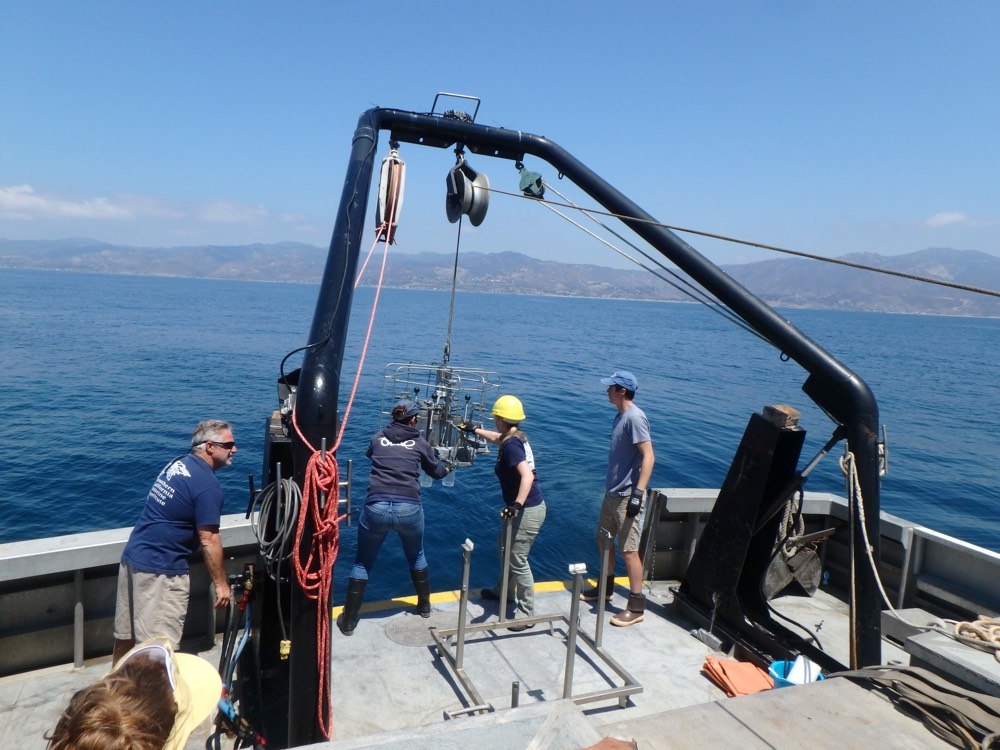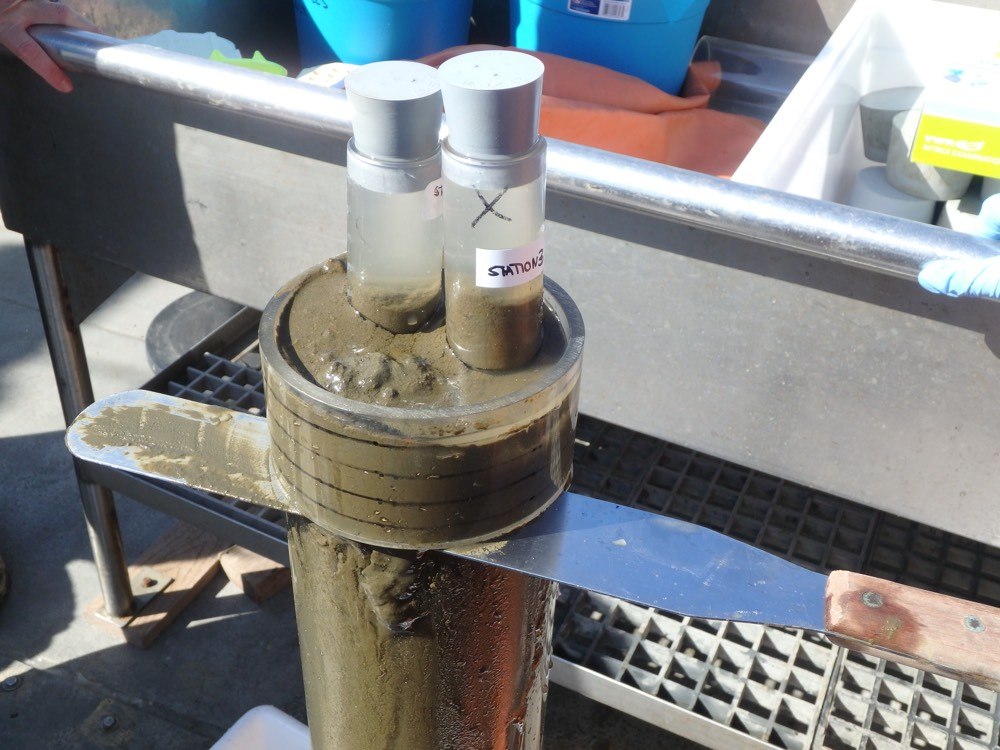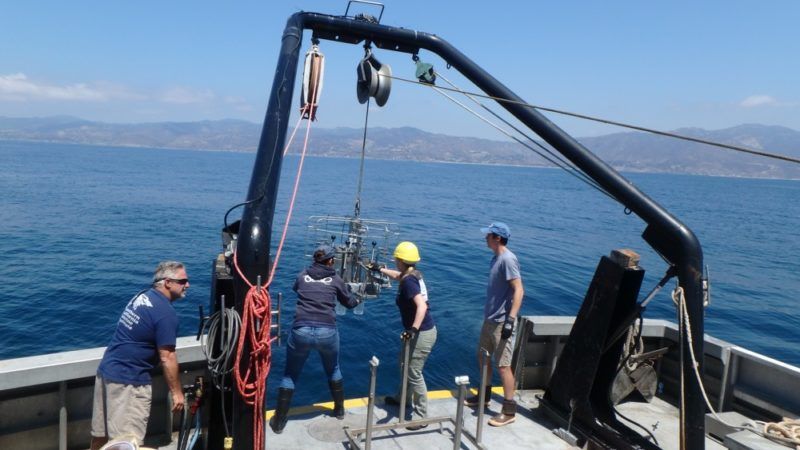Principal Investigators: Will Berelson (University of Southern California) and Tina Treude (University of California, Los Angeles)
The ocean is warming, as is the planet, and one consequence, direct or indirect, is a redistribution of oxygen and a decline in oxygen across many regions. The Southern California Bight region has been experiencing a decline in water column oxygen within the oxygen minimum zone such that low oxygen waters are even further depleted and the zone or width of low oxygen (hypoxic) water has expanded. The cause(s) of this decline are not well known nor are the consequences. The oxygen minimum zone intersects the sediments adjacent to Los Angeles at a depth of approx. 200 m. Yet with further shoaling of the upper boundary this low-oxygen water will contact sediments that have heretofore been overlain by oxic waters.
Hypoxia at the seafloor has major consequences for biological processes. Benthic macrofauna may suffocate. Sediments, which are no longer bioturbated or bioirrigated by macrofaunal inhabitants, will reduce exchange processes with the water column and form laminations. Oxygen sensitive nutrients such as iron and bound phosphate will be released from the seafloor and feed the shallow photosynthetic zone. Fertilized primary productivity will result in higher export of organic matter to the seafloor, which consumes more oxygen during its metabolic degradation. This sort of positive feedback would certainly exacerbate the dire conditions of encroaching hypoxia.
Within this Sea Grant project we assess sedimentary metrics from the Santa Monica Basins, such as dating of laminations, sediment and bottom water biogeochemistry, presence of macrofauna, that track historic changes in local ocean oxygen content and reveal the status quo. Our main working tools in the field are a probe for the profiling of several water column parameters and a miniaturized multicorer, an instrument that can collect 4 sediment cores from the seafloor. In spring and summer 2016 we conducted several day trips with the R/V YELLOWFIN, a 76 feet research vessel operated by the Southern California Marine Institute, to study sediment and water characteristics from the shallow (70 m) to the deep (900 m) seafloor in the Santa Monica Bay.
Anticipated Benefits of the Study
We have focused this study to provide specific benefit to various stakeholders. The public sanitation districts are interested in changes that are occurring in local waters and how those changes can be attributed to anthropogenic and natural forcing. The sediments are a repository of information about changing productivity and sedimentation, and we will provide a ‘map’ of changes that may have occurred over the past 25-35 years. This time-window is a critical time in terms of anthropogenic changes in the local ocean. The seafloor is a key ecosystem to benthic invertebrates that fish and mammals feed upon, to benthic fish, but also to squid that are the major fishery in the Southern California Bight. A reduction of this habitat through the spreading of hypoxia could have severe consequences for existing fishing grounds. We need to understand the status of our backyard ocean.
Background information about the Santa Monica Basin
The Santa Monica Basin is part of the California Continental Borderland, which forms a broad, tectonically shaped continental margin off Southern and Baja California, consisting of a set of inner, central, and outer basins separated by channel islands or sills. Given their proximity to the coastline, the basin form a natural trap for sediments with terrigenous, biogenous, and antrophogenous sources. The topographic isolation of these basins restricts water exchange at depth, creating hypoxic zones. Flushing events sometimes interrupt these periods of water stagnation, delivering cooler, oxygen-rich water into the basins. The deoxygenation of the Santa Monica Basin started approximately 350 yrs. BP, most likely as a consequence of a warming shift in global climate. However, spreading of the oxygen-deficient zones has been amplified over the past 200-150 yrs., presumably due to changes in drainage from the mainland and increase in oxygen demand caused by anthropogenic input.
Suggested further readings
Berelson, W.M., 1991. The flushing of two deep-sea basins, southern California borderland. Limnology and Oceanography 36, 1150-1166.
Christensen, C.J., Gorsline, D., Hammond, D.E., Lund, S.P., 1994. Non-annual laminations and expansion of anoxic basin-floor conditions in Santa Monica Basin, California Borderland, over the past four centuries. Marine Geology 116, 399-418.
Gorsline, D.S., 1992. The geological setting of Santa Monica and San Pedro Basins, California Continental Borderland. Progress in Oceanography 30, 1-36.
Treude, T., 2012. Biogeochemical reactions in marine sediments underlying anoxic water bodies, in: Altenbach, A., Bernhard, J., Seckbach, J. (Eds.), Anoxia: Paleontological Strategies and Evidence for Eukaryote Survival. Springer, pp. 19-38.


Contact: Tina Treude, ttreude@g.ucla.edu

